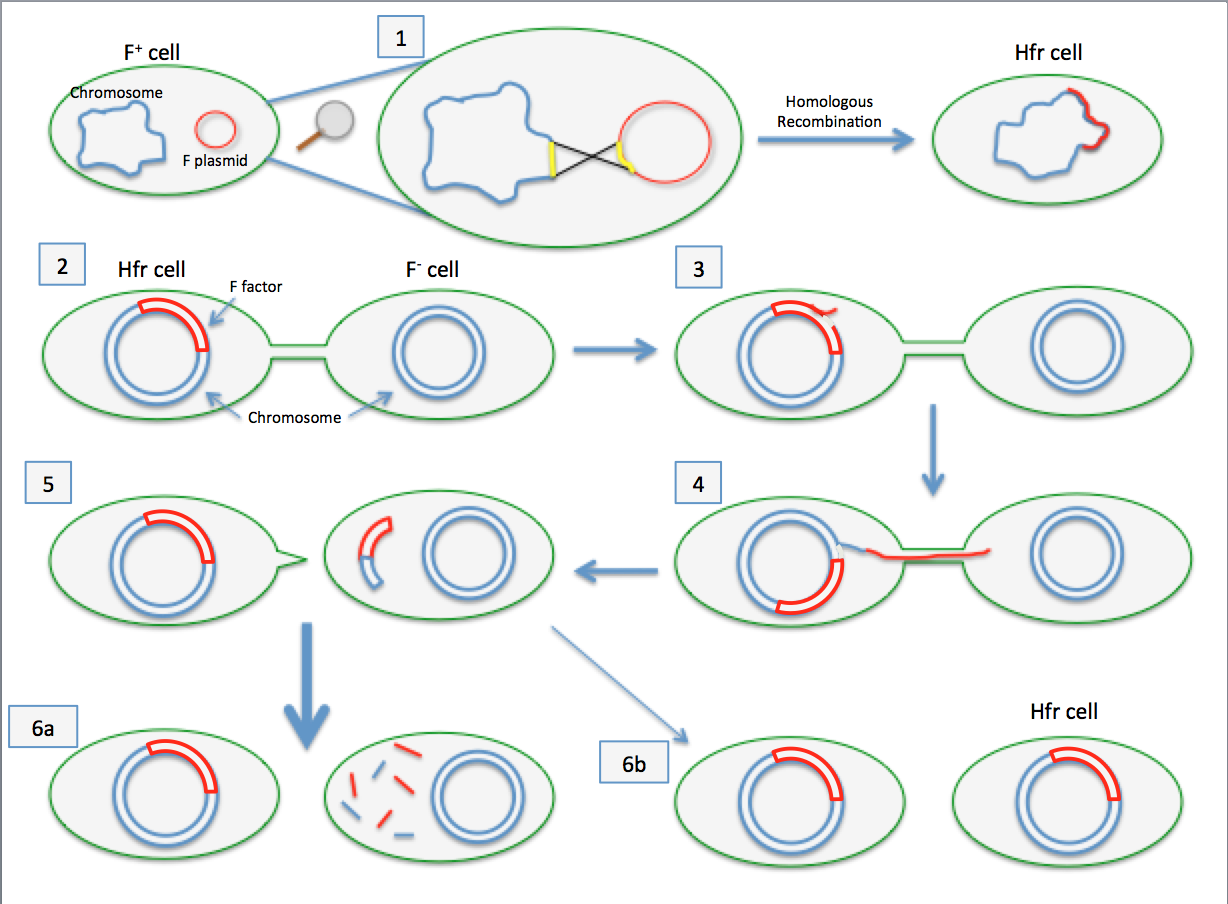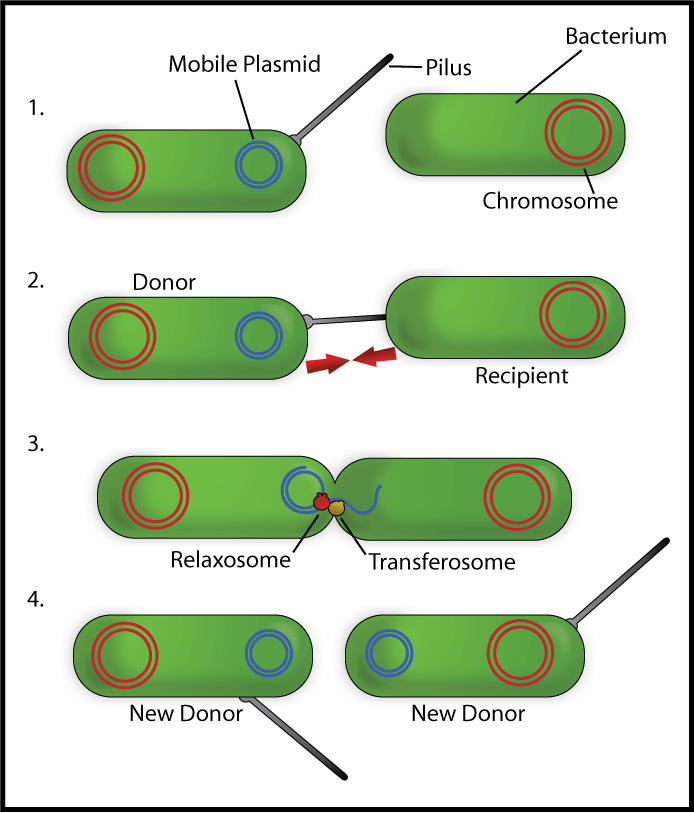|
Hfr Cell
A high-frequency recombination cell (Hfr cell) (also called an Hfr strain) is a bacterium with a conjugative plasmid (for example, the F-factor) integrated into its chromosomal DNA. The integration of the plasmid into the cell's chromosome is through homologous recombination. A conjugative plasmid capable of chromosome integration is also called an episome (a segment of DNA that can exist as a plasmid or become integrated into the chromosome). When conjugation occurs, Hfr cells are very efficient in delivering chromosomal genes of the cell into recipient F− cells, which lack the episome. History The Hfr strain was first characterized by Luca Cavalli-Sforza. William Hayes also isolated another Hfr strain independently. Transfer of bacterial chromosome by Hfr cells An Hfr cell can transfer a portion of the bacterial genome. Despite being integrated into the chromosomal DNA of the bacteria, the F factor of Hfr cells can still initiate conjugative transfer, without being ... [...More Info...] [...Related Items...] OR: [Wikipedia] [Google] [Baidu] |
Bacterium
Bacteria (; singular: bacterium) are ubiquitous, mostly free-living organisms often consisting of one biological cell. They constitute a large domain of prokaryotic microorganisms. Typically a few micrometres in length, bacteria were among the first life forms to appear on Earth, and are present in most of its habitats. Bacteria inhabit soil, water, acidic hot springs, radioactive waste, and the deep biosphere of Earth's crust. Bacteria are vital in many stages of the nutrient cycle by recycling nutrients such as the fixation of nitrogen from the atmosphere. The nutrient cycle includes the decomposition of dead bodies; bacteria are responsible for the putrefaction stage in this process. In the biological communities surrounding hydrothermal vents and cold seeps, extremophile bacteria provide the nutrients needed to sustain life by converting dissolved compounds, such as hydrogen sulphide and methane, to energy. Bacteria also live in symbiotic and parasitic relationshi ... [...More Info...] [...Related Items...] OR: [Wikipedia] [Google] [Baidu] |
Bacterial Conjugation
Bacterial conjugation is the transfer of genetic material between bacterial cells by direct cell-to-cell contact or by a bridge-like connection between two cells. This takes place through a pilus. It is a parasexual mode of reproduction in bacteria. It is a mechanism of horizontal gene transfer as are transformation and transduction although these two other mechanisms do not involve cell-to-cell contact. Classical ''E. coli'' bacterial conjugation is often regarded as the bacterial equivalent of sexual reproduction or mating since it involves the exchange of genetic material. However, it is not sexual reproduction, since no exchange of gamete occurs, and indeed no generation of a new organism: instead an existing organism is transformed. During classical ''E. coli'' conjugation the ''donor'' cell provides a conjugative or mobilizable genetic element that is most often a plasmid or transposon. Most conjugative plasmids have systems ensuring that the ''recipient'' cell does not al ... [...More Info...] [...Related Items...] OR: [Wikipedia] [Google] [Baidu] |
Plasmid
A plasmid is a small, extrachromosomal DNA molecule within a cell that is physically separated from chromosomal DNA and can replicate independently. They are most commonly found as small circular, double-stranded DNA molecules in bacteria; however, plasmids are sometimes present in archaea and eukaryotic organisms. In nature, plasmids often carry genes that benefit the survival of the organism and confer selective advantage such as antibiotic resistance. While chromosomes are large and contain all the essential genetic information for living under normal conditions, plasmids are usually very small and contain only additional genes that may be useful in certain situations or conditions. Artificial plasmids are widely used as vectors in molecular cloning, serving to drive the replication of recombinant DNA sequences within host organisms. In the laboratory, plasmids may be introduced into a cell via transformation. Synthetic plasmids are available for procurement over the inter ... [...More Info...] [...Related Items...] OR: [Wikipedia] [Google] [Baidu] |
Fertility Factor (bacteria)
The fertility factor (first named F by one of its discoverers Esther Lederberg; also called the sex factor in '' E. coli'' or the F sex factor; also called F-plasmid) allows genes to be transferred from one bacterium carrying the factor to another bacterium lacking the factor by conjugation. The F factor was the first plasmid to be discovered. Unlike other plasmids, F factor is constitutive for transfer proteins due to a mutation in the gene ''finO''. The F plasmid belongs to a class of conjugative plasmids that control sexual functions of bacteria with a fertility inhibition (Fin) system. Discovery Esther M. Lederberg and Luigi L. Cavalli-Sforza discovered "F," subsequently publishing with Joshua Lederberg. Once her results were announced, two other labs joined the studies. "This was not a simultaneous independent discovery of F (I names as Fertility Factor until it was understood.) We wrote to Hayes, Jacob, & Wollman who then proceeded with their studies." The discovery of ... [...More Info...] [...Related Items...] OR: [Wikipedia] [Google] [Baidu] |
Chromosome
A chromosome is a long DNA molecule with part or all of the genetic material of an organism. In most chromosomes the very long thin DNA fibers are coated with packaging proteins; in eukaryotic cells the most important of these proteins are the histones. These proteins, aided by chaperone proteins, bind to and condense the DNA molecule to maintain its integrity. These chromosomes display a complex three-dimensional structure, which plays a significant role in transcriptional regulation. Chromosomes are normally visible under a light microscope only during the metaphase of cell division (where all chromosomes are aligned in the center of the cell in their condensed form). Before this happens, each chromosome is duplicated ( S phase), and both copies are joined by a centromere, resulting either in an X-shaped structure (pictured above), if the centromere is located equatorially, or a two-arm structure, if the centromere is located distally. The joined copies are now called si ... [...More Info...] [...Related Items...] OR: [Wikipedia] [Google] [Baidu] |
Homologous Recombination
Homologous recombination is a type of genetic recombination in which genetic information is exchanged between two similar or identical molecules of double-stranded or single-stranded nucleic acids (usually DNA as in cellular organisms but may be also RNA in viruses). Homologous recombination is widely used by cells to accurately DNA repair harmful breaks that occur on both strands of DNA, known as double-strand breaks (DSB), in a process called homologous recombinational repair (HRR). Homologous recombination also produces new combinations of DNA sequences during meiosis, the process by which eukaryotes make gamete cells, like sperm and egg cells in animals. These new combinations of DNA represent genetic variation in offspring, which in turn enables populations to adapt during the course of evolution. Homologous recombination is also used in horizontal gene transfer to exchange genetic material between different strains and species of bacteria and viruses. Horizontal ... [...More Info...] [...Related Items...] OR: [Wikipedia] [Google] [Baidu] |
Episome
An episome is a special type of plasmid, which remains as a part of the eukaryotic genome without integration. Episomes manage this by replicating together with the rest of the genome and subsequently associating with metaphase chromosomes during mitosis. Episomes do not degrade, unlike standard plasmids, and can be designed so that they are not epigenetically silenced inside the eukaryotic cell nucleus. Episomes can be observed in nature in certain types of long-term infection by adeno-associated virus or Epstein-Barr virus. In 2004, it was proposed that non-viral episomes might be used in genetic therapy for long-term change in gene expression. As of 1999, there were many known sequences of DNA (deoxyribonucleic acid) that allow a standard plasmid to become episomally retained. One example is the S/MAR sequence. The length of episomal retention is fairly variable between different genetic constructs and there are many known features in the sequence of an episome which will aff ... [...More Info...] [...Related Items...] OR: [Wikipedia] [Google] [Baidu] |
Luca Cavalli-Sforza
Luigi Luca Cavalli-Sforza (; 25 January 1922 – 31 August 2018) was an Italian geneticist. He was a population geneticist who taught at the University of Parma, the University of Pavia and then at Stanford University. Works Schooling and positions Cavalli-Sforza entered Ghislieri College in Pavia in 1939 and he received his M.D. from the University of Pavia in 1944. In 1949, he was appointed to a research post at the Department of Genetics, Cambridge University by the statistician and evolutionary biologist Ronald A. Fisher in the field of '' E. coli'' genetics. In 1950, he left the University of Cambridge to teach in northern Italy (Parma, and Pavia) before taking up a professorship at Stanford in 1970. He remained at Stanford until he retired in 1992. In 1999 he won the Balzan Prize for the Science of human origins. He has been a member of the Pontifical Academy of Sciences since 1994. In 1992 he was elected Foreign Member of the Royal Society of London. He was awarded the ... [...More Info...] [...Related Items...] OR: [Wikipedia] [Google] [Baidu] |
William Hayes (geneticist)
William Hayes FRCPI FRS FRSE LLD (18 January 1913 – 7 January 1994) was an Irish geneticist. Early life He was born in Rathfarnham, Co Dublin, the only son of William Hayes, a successful Dublin pharmacist, and his second wife, Miriam, née Harris. Hayes was still a child when his father died, and he lived with his mother and grandmother and was educated at home by a governess, before going to a preparatory school in Dalkey and then in 1927 to St Columba's College at Rathfarnham, where his early interest in science began to develop as a hobby. He read medicine at Trinity College, Dublin, graduated BA in Natural Science in 1936 and qualified in medicine the following year (MB, BCh, University of Dublin). Career He completed internships at the Victoria Hospital, Blackpool and Sir Patrick Dun's Hospital, Dublin, before becoming an Assistant to his mentor, Professor J W Bigger, in the Department of Bacteriology at Trinity College. Here his work included routine diagnostic bacteri ... [...More Info...] [...Related Items...] OR: [Wikipedia] [Google] [Baidu] |
Mating Bridge
A mating bridge, also known as a conjugation or population bridge, is a connection between two bacterial cells that provides a passageway for DNA in bacterial conjugation. A mating bridge is different from a sex pilus, which is a structure made by an F+ strain bacterium in bacterial conjugation Bacterial conjugation is the transfer of genetic material between bacterial cells by direct cell-to-cell contact or by a bridge-like connection between two cells. This takes place through a pilus. It is a parasexual mode of reproduction in bacteri .... The pili (plural) act as attachment sites that promote the binding of bacteria to each other. In this way, an F+ strain makes physical contact with an F− strain. Once contact is made, the pili shorten and thereby draw the donor and recipient cells closer together. A conjugation bridge is then formed between the two cells, which provides a passageway for DNA transfer. References {{Reflist Bacteriology Organelles ... [...More Info...] [...Related Items...] OR: [Wikipedia] [Google] [Baidu] |
Sex Pilus
A pilus (Latin for 'hair'; plural: ''pili'') is a hair-like appendage found on the surface of many bacteria and archaea. The terms ''pilus'' and '' fimbria'' (Latin for 'fringe'; plural: ''fimbriae'') can be used interchangeably, although some researchers reserve the term ''pilus'' for the appendage required for bacterial conjugation. All conjugative pili are primarily composed of pilin – fibrous proteins, which are oligomeric. Dozens of these structures can exist on the bacterial and archaeal surface. Some bacteria, viruses or bacteriophages attach to receptors on pili at the start of their reproductive cycle. Pili are antigenic. They are also fragile and constantly replaced, sometimes with pili of different composition, resulting in altered antigenicity. Specific host responses to old pili structures are not effective on the new structure. Recombination genes of pili code for variable (V) and constant (C) regions of the pili (similar to immunoglobulin diversity). As the pr ... [...More Info...] [...Related Items...] OR: [Wikipedia] [Google] [Baidu] |


